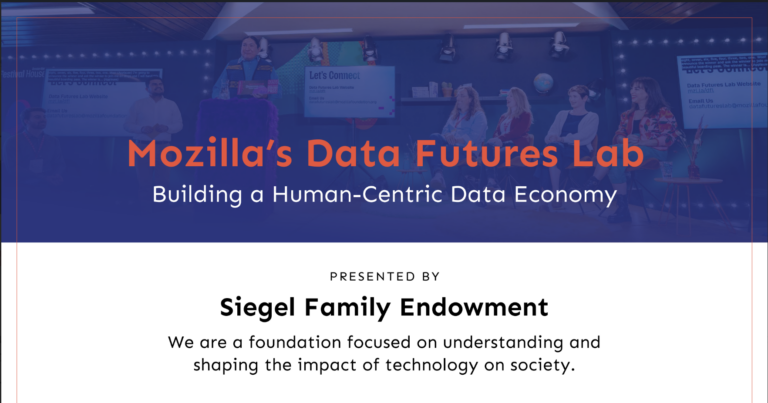Last Mile Education Fund’s CEO reflects on abundance, ROI, & financial barriers to graduation
There are tens of thousands of college students around the country who are most of the way through completing a tech degree, but because they lack financial resources, are struggling to make it to graduation day. A surprisingly small investment to get students through that “last-mile” can yield outsized benefits for the student and society.
Tech-related degrees result in high-paying jobs and large lifetime earnings that translate into higher tax revenue. The cost to society of not getting these students to graduation day and into jobs—lost tax revenue, sunk costs in K-12 education, lack of diversity in the workforce—is staggering.
The Last Mile Education Fund was built on the twin realizations about the low cost of bridging the “last mile” and about the myriad positive impacts of getting these students over the finish line. Since it launched in 2020, Last Mile has awarded over 6000 grants totaling nearly $6 million to support degree completion for low-income underrepresented students who are training for careers in tech.
We sat down with Last Mile’s founder and CEO, Ruthe Farmer, to discuss the practical challenges that college students from low-income backgrounds face, Last Mile’s “abundance approach,” and what industry and higher education can do to better support students in their last mile.
What led you to found the Last Mile Education Fund? What challenges were you trying to address?
Throughout my experience working in diversity and inclusion in tech, I connected with lots of young women at different stages in the pipeline. I kept seeing really promising students stumbling in the late stages of their programs. The K-20 tech education community has done great work on the front end to get students into tech pathways, but structural barriers in the college experience are keeping low-income students from actually succeeding.
A specific example of this comes from Rian (Walker) Ferria, our co-founder. She was engaged in Aspirations in Computing, a program I led. Her professor Dr. Sarah Lee and I helped her to attend a major tech recruiting conference. She didn’t have a credit card, so I used mine to check her into the hotel for the conference. The assumption is that everyone has access to capital or credit, which is not true for most of the students we serve.
Here’s another example. In 2017, Rian had a confirmed internship at one of the biggest banks in the United States, and she nearly canceled it because she couldn’t afford travel to the internship site or to secure a place to live until she got paid. Even in compensated internships, you often get reimbursed for relocation rather than receiving the money upfront. There’s this assumption of access to capital and credit that is harming students who don’t have a safety net. Rian felt comfortable enough to ask Sarah and me for help, but many students don’t have a relationship like that.
Your organization is called The Last Mile Education Fund. What does that name refer to? How does it reflect your mission and approach?
We are serving students in the “last mile” of their education. Our market is students who are midway through a degree or certificate program in a tech field and who are at risk of stopping or dropping out because of financial hurdles.
There are huge benefits to focusing on this group. By the time a student has made it to their junior year of college in a field like engineering or computer science, by our back-of-the-envelope estimate society has invested well over $477,000. Factor in the cost of K-12 school, the cost of raising a child, add two years of college, plus a premium for all the STEM education outreach work that’s being done. That’s a lot of sunk costs.
If that student doesn’t graduate, we all lose. They will not live up to their potential. They don’t join the tech workforce. We’re missing their diverse contributions to innovation. The student and society will have the worst possible outcome—someone with two (or more) years of college debt and no degree.
Whereas we can invest a relatively small amount—our average grant hovers around $1000—to get them over the finish line. They will earn more, they will pay more in taxes, they will contribute more economically for the rest of their lives, and their families will as well. Moreover they will contribute to the innovation economy, both in sheer numbers and in diversity of thought. The ROI on these investments is incalculable.
The Last Mile Education Fund isn’t a typical scholarship program. What makes your approach unique?
Traditional scholarships are typically aimed at identifying “outliers.” They try to find the best and the brightest kid in high school and launch them into college. They want a sure thing. They have students compete against each other for scarce resources. That scarcity mindset is also reflected in financial aid, where the wealthiest students get 34% more non-federal financial aid than the poorest.
We take a different approach. There are scores of striving students out there who lack the academic and basic resources to be outliers. They are struggling with housing insecurity, food insecurity, access to the internet, using antiquated computers, and on and on. In my mind, if a student of color from a low-income background is raising their hand, and saying, “I desperately want to be a software engineer,” we should give them the best computer, the best internet, and not expect them to work 30 hours a week. The outcome for society is huge.
The Last Mile Education Fund takes an “abundance approach.” The main goal is to help the students graduate, not to create additional blockers. We don’t ask for GPA. We don’t police what they do with the money. We trust them. If a student is brave enough to come to us and say, “I need your help,” we believe in them. The risks to us are low. We’re giving relatively small grants, and we do the necessary due diligence and interview them, and get all the relevant paperwork, but we’re not making them perform their poverty.
What are some of the areas where students most frequently request assistance?
Your financial aid package is calculated as much as a year in advance of you going to that school. It doesn’t take into consideration unexpected expenses, like the car that you relied on to get to the two jobs that make it possible for you to afford college breaking down.
We have paid for car repairs, we have paid for dental work, medical bills, cell phone plans. None of those qualify as educational expenses and aren’t covered by traditional scholarships under IRS rules, but they’re essential for being able to perform well in school. We have paid for a student to bury their parent, because as the oldest child, they had to come up with money for the funeral. If not, they would have had to drop out of school to earn that money.
We had a student who lost everything in a flood a week before her final term of college. If she had to wait for FEMA assistance, her chances of finishing her college degree would go down dramatically. We had a MacBook Pro available for her to pick up at Best Buy the next day. She had asked her institution for a device but they were only able to offer her a Chromebook, which was wholly inadequate for a senior in computer science. We got her an air mattress and blankets. That immediate investment made it possible for her to stay in school and finish college.
The number one request we get for funding is actually tuition, but I would say that it’s actually things that the institutions ask students to pay for. That can be everything from parking tickets, to library fines, book fees, activity fees, hidden costs that are not part of the sticker price. These hidden costs really shut out low-income students.
We gave a student money to buy a parking pass so that she could return to class in-person, for example. If she’s not showing up in person, she is not the person that a professor is going to recommend when an alum calls looking for an intern. The assumption is that you’re unengaged or that you’re lazy if you only show up on Zoom, but the reality is that you can’t afford to park on campus.
Similarly, we often help students pay unpaid balances that are keeping them from registering for classes. That balance could be as low as a few hundred dollars, which is a meaningless amount to prevent them from re-enrolling, and that institution reaping that whole next term of financial aid.
Throughout this discussion, you often refer to “investments” and “ROI.” That’s very different from the language that most scholarship programs adopt. Why have you adopted that language?
According to the 2019 NACE salary survey the average starting salary for computer science graduates is over $70,000, nearly double the average starting salary of English majors. By our calculations, every student who graduates and launches into tech is going to earn, on average, over $40,000 a year more than they would with some college and no degree. Since our average grant is $1000, we can invest in a lot of students. If just one graduates—one out of forty—the ROI is there. We have a much higher graduation rate than that, of course. But when we talk about “investment,” we’re talking about both investment in the individual, and in the returns that it brings to their family, the companies where they work, and society at large.
We also talk about a “virtuous circle,” where recipients of Last Mile grants reinvest in the organization. It’s much more than a funding source for us. We’re investing in students who are going to get jobs in tech companies, and those students are going to spread the word to their employer networks. They’re going to bring their companies along. Maintaining a connection to our alumni is the way that future grantees get hired and get connected. More and more, social capital is part of the process of getting hired into tech. As we are launching students from low-income backgrounds into tech, they will bring more students like themselves into the companies that have hired them. This also establishes a community that students from low-income backgrounds can seek out when they arrive at a tech company.
That’s an interesting point—that the goal is not just to have students graduate, but to launch them into successful careers. What can industry do to support the students that you invest in?
At Last Mile Education Fund, we’re finding a population of students that you’re not going to find in large numbers at the universities where tech companies typically recruit. The population of students that we are investing in are not only low-income, but they heavily trend towards Black and Latinx.
There needs to be a change in thinking in industry so that they’re looking at the kinds of students that we identify. I actually co-authored an article about this entitled, “Tech Companies: Stop Conflating Privilege with Potential.” A lot of the things that companies are considering as markers of potential—the school you went to, the internships you’ve had, or the GPA you have—are actually much more a factor of the zip code you were born into and your socioeconomic status rather than a measure of your innate talent or your ability to contribute to an organization.
Companies are over-valuing those markers and undervaluing things like whether a first generation student put herself through community college and transferred to a state college and worked retail for eight years to get a degree in computer science. That student has proven problem solving skills, proven resilience, stamina, and a commitment to the field that’s not recognized in the hiring process.
The other piece is that the hiring systems assume affluence. One thing I would really love is for all companies to give every new intern a $2,500 gift card upfront to pay for that person to get there. Don’t wait to reimburse them after they start. The company can afford the very small risk of losing $2,500, but the student can’t afford the risk of forgoing this internship because they don’t have the money to fly themselves there and secure a safe place to stay.
Another example of this is how companies say, “You can’t get hired until you show us your diploma.” Meanwhile, the university says, “You can’t have your diploma until you pay this outstanding bill.” It becomes this stupid stalemate where you’ve got a student who is about to get a six figure job and a sign-on bonus who is stuck in limbo.
Finally, every tech company should set aside a percentage of their university recruiting budget to invest in students in their “last mile.” What is going to endear you to a potential new hire more—the fact that you gave them a water bottle or a hoodie at a career fair, or that you paid their rent their senior year of college? If you’re an employer, wouldn’t you rather that the student is spending their spring term doing the 400 and 500-level computing classes that are prepaying your professional development, rather than trying to crowdfund their rent?
What industry partnerships does Last Mile Fund have to help create the changes that you’ve described?
We recently announced the Applied Materials Momentum Fund. It’s a three-year pilot program to support degree completion among low-income, undergraduate women preparing for engineering careers in the semiconductor industry.
Industry partnerships can be very effective. We have a scholarship fund for cybersecurity students in partnership with Microsoft. We also have a fund with Dow Chemical for students in manufacturing and skilled trades. Other corporations have donated directly to our general fund, enabling us to support the students that need it most and respond to needs as they arise
We’ve talked about the industry side. What can institutions of higher education do to support the students that you’re investing in?
We are trying to let the institutions know what the barriers to graduation are for this group of students. For example, we take the data from our grant-making back to the institution, and say, “Hey, University: 80% of your students that ask us for help are struggling with housing.”
Often the on-campus resources that do exist are hard to find and require students to jump through a lot of bureaucratic hoops. There’s one school that has an emergency fund, but they make the students submit receipts for everything. Monitoring is a huge waste of time and money for such small grants and sends the message that they don’t trust low-income students. Universities could change that approach.
We’re also embarking on research partnerships to understand the experiences of low-income students getting a technical degree, and exploring barriers faced by students of different backgrounds. For example, because low-income students are heads-down on survival and focused on making enough money to pay their rent, to keep studying, to keep doing their work, they are often unable to participate in many of the critical career-building opportunities that institutions provide —mentoring, conferences, internships, career counseling. We’re finding that not only do they not have the information, but they don’t even know they’re supposed to get the information. We’re working on those challenges with students, but that’s something that higher ed can also address.
What are you most excited about as you look to the future of the Last Mile Fund? How can folks get involved with your work?
I’m really excited about the potential impact that we can have if we focus on these students who are in their last mile—essentially proving that Last Mile’s abundance-based approach yields better outcomes than typical scarcity-based approaches. The ROI for us as a society is permanent, sustainable and renewable.
In order to do that work, we want to invest in every possible student and build relationships with employers to help them launch. Interested students can apply. Individuals, companies, and philanthropic organizations can donate. Potential industry partners can reach out. And individuals can sign up for Last Mile’s newsletter and follow us on social media.
####
Ruthe Farmer is CEO and founder at Last Mile Education Fund. Throughout her career, Farmer has focused on inclusion and leveraging existing infrastructure to scale change. She previously served as chief evangelist at CSforAll, was senior policy advisor for tech inclusion in the Obama White House, and chief strategy & growth officer at the National Center for Women & IT. Farmer has been internationally recognized for her work. Among other honors, she was named a 2013 White House Champion of Change for Technology Inclusion and received both the 2014 Anita Borg Institute Award for Social Impact and the inaugural UK Alumni Award for Social Impact in 2015.





